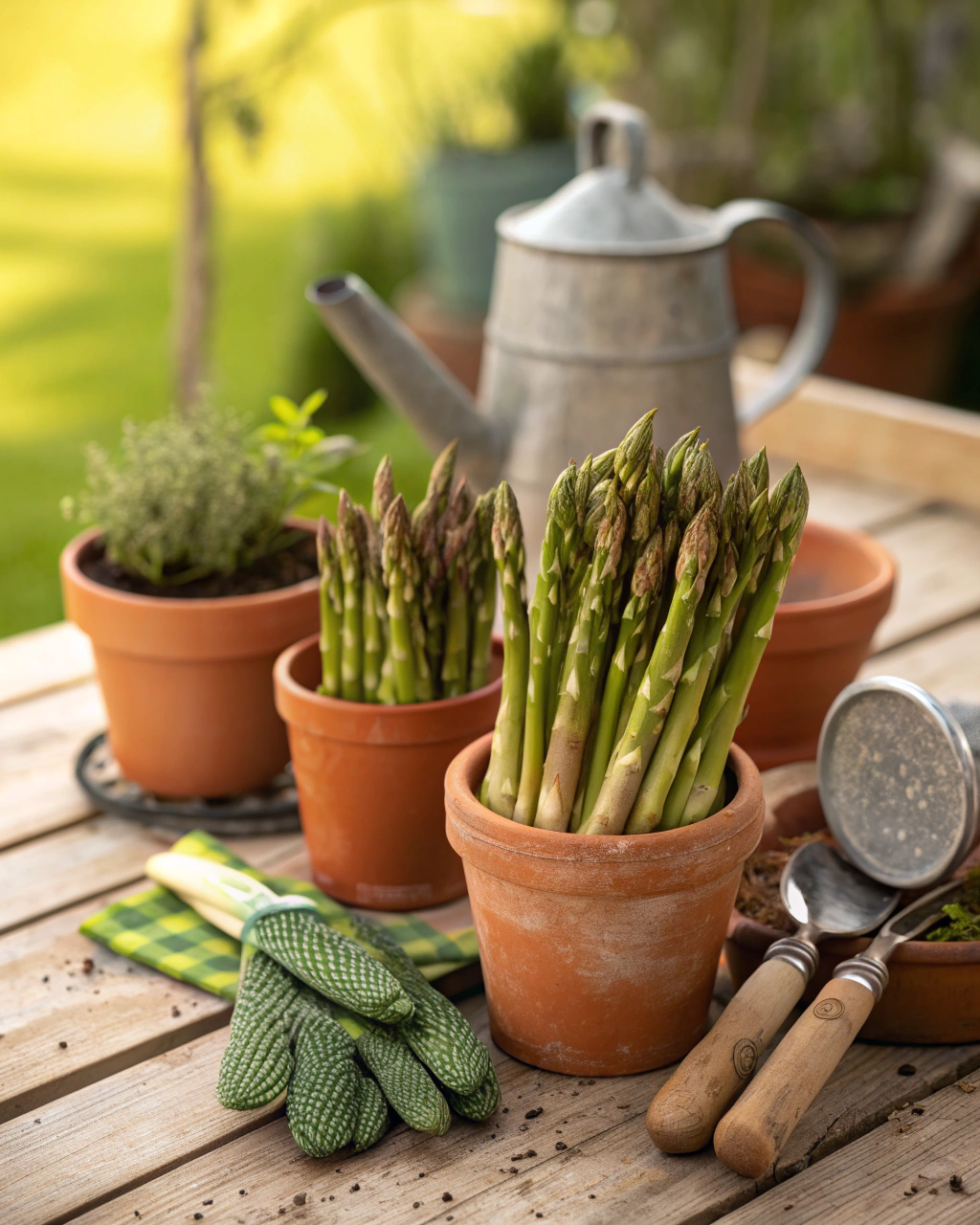Why Grow Asparagus in Pots? Patience Rewarded
You might wonder why you’d take on asparagus—a plant that demands time and care when you can buy it fresh. But here’s the truth: asparagus is a perennial treasure that grows back year after year, rewarding your patience with tender, sweet stalks that supermarket versions rarely match. Even if you have limited space—like a small balcony or patio—you can grow asparagus successfully in pots. It’s a gardener’s delight that connects you to the slow, steady rhythm of nature. I’ll guide you through clear, practical steps so you feel confident tackling soil, pests, and watering challenges. By the end of this, you’ll be ready to welcome your own spears, savour their fresh crunch, and appreciate your green thumb in a whole new way.
Getting Ready — What You’ll Need
Before planting asparagus in pots, gather the essentials to set yourself—and your plants—up for success. Here’s the checklist with reasons why each item matters:
- Container: Choose a pot at least 30 cm (12 inches) deep and 40 cm (16 inches) wide or larger. This gives enough space for the roots to develop deeply and prevents dryness. (If your area gets very hot, consider clay pots; they keep roots cooler than plastic.)
- Drainage holes: Your pot must have multiple holes to avoid waterlogging, which causes root rot.
- Soil mix: A loose, well-draining mix with 70% loam or good garden soil, 20% aged compost for nutrients, and 10% coarse sand or perlite to maintain airflow and moisture balance.
- Fertilizer: Use a low nitrogen fertilizer or balanced fertilizer (e.g., 10-10-10 NPK), which encourages healthy root and spear growth without excessive leafy shoots.
- Seeds or crowns: Crowns (1-year-old root divisions) give quicker results, but seeds are rewarding if you’re patient. Look for varieties like ‘Mary Washington’ or ‘Jersey Giant’.
- Watering can or hose: For deep watering that moistens soil at the base without splashing foliage.
- Gardening trowel and hand fork: To gently work the soil and transplant without damaging delicate roots.
- pH tester: Asparagus prefers slightly acidic to neutral soil, around pH 6.5–7.0. Adjust with lime or sulfur as needed.
- Sunlight: Pick a spot receiving at least 6–8 hours of direct sunlight daily, critical for strong spear development.
(If on a budget, use recycled pots with added drainage holes and make your own compost. Sand can be replaced by perlite or small gravel.)
Step-by-Step — How to Grow in Pots
1. Preparing Your Pot
Start by thoroughly cleaning your pot with warm water and mild soap to remove any residues or pests from previous plantings. Rinse well. Drainage is key. Add a layer of coarse material—broken terracotta, small stones, or gravel—about 3–5 cm (1–2 inches) deep at the bottom. This prevents drainage holes from clogging and keeps roots from sitting in water.
Next, fill your pot with the soil mix described earlier. Aim for a moisture level similar to “a sponge wrung out”—damp but not soggy. Avoid compressing the soil too firmly; asparagus roots need air and space to explore. Gently firm the surface, but don’t pack it down. A common mistake is using heavy or compacted soil and skipping drainage holes, which leads to root rot and weak growth.
2. Sowing or Planting
If you’re sowing seeds, soak them overnight in warm water to jumpstart germination. Plant seeds at a depth of 0.5–1 cm (¼–½ inch), spacing them about 10–15 cm (4–6 inches) apart if growing multiple crowded in one pot. Keep the soil temperature between 18–24°C (65–75°F)—consistent warmth encourages healthy sprouts.
If planting crowns, dig a shallow trench about 15 cm (6 inches) deep in your prepared pot. Space crowns about 20 cm (8 inches) apart. Cover the roots completely, but don’t crush the crown. After planting, water gently to settle soil around roots without washing them away. You should feel moist, friable soil beneath your fingers, neither bone-dry nor waterlogged.
Pro tip: Cover new plantings with a thin layer of mulch (straw or leaf mold) to conserve moisture and regulate temperature during early growth.
3. Watering and Sunlight
Watering asparagus in pots requires balance—too little, and the roots dry out; too much, and you risk rot. Aim to water deeply until you see moisture at the base of the pot, about 2–3 times per week in warm weather. Feel the top 2–3 cm (about 1 inch) of soil; if it’s dry, it’s time to water.
In hot or windy climates, water more frequently and consider grouping pots close together to reduce evaporation. Mulching around the shoots helps maintain humidity. If you’re in a sunnier zone with persistent heat, morning sun with afternoon partial shade is ideal to avoid sunburn on young spears.
Asparagus thrives with 6–8 hours of direct sunlight daily. If you live in a cloudy or shaded region, place pots in the brightest spot available and consider reflective white surfaces nearby to boost light intensity.
4. Feeding and Maintenance
Feed asparagus every 3–4 weeks during the growing season with a balanced or low nitrogen fertilizer. Avoid high nitrogen doses that encourage excessive leafy growth instead of strong spears. Compost water or liquid seaweed feed works wonderfully for steady nutrition.
Thin out weak shoots after they emerge to give space and airflow to healthy spears. Gently probe the soil surface monthly with a hand fork to maintain aeration—compacted soil is a common cause of poor root development.
Watch your plant closely: yellowing leaves often point to nutrient imbalances, while soggy or wilting stems suggest overwatering or poor drainage. “The secret is not more work — it’s regular care and observation,” I’ve found firsthand after years growing asparagus.
5. Troubleshooting While They Grow
If you notice yellow leaves, it could be too much nitrogen in your fertilizer. Switch to one with higher phosphorus, or add organic compost to balance nutrients. Stunted growth often means roots lack oxygen—check drainage holes and soil texture.
Asparagus can face pests like aphids or asparagus beetles. Spray affected shoots gently with water or use organic insecticidal soap if needed. Misshapen roots or poor emergence usually signal compacted or poorly mixed soil; aim to refresh your soil and add perlite or coarse sand next season.
6. Harvesting
Harvest timing is key. Typically, meaty, firm spears appear after 70–90 days from planting crowns. They should be 15–25 cm (6–10 inches) tall, thick, and vibrant green or purple (depending on the variety). The spear’s “snap” is your best indicator—a crisp break without bending means it’s ready.
To harvest, grasp the spear gently at the base just above soil level, then snap or cut cleanly. Avoid pulling too hard—you don’t want to damage roots that will produce next year’s crop.
Pro tip: For a sweeter flavor, reduce watering in the last week before harvest. This concentrates sugars within the spear.
Store asparagus in a cool, dark place at about 4–7°C (39–45°F), wrapped loosely in damp paper towels or a perforated bag. It will keep fresh for up to 2 weeks. Alternatively, preserve excess harvest by pickling, blanching and freezing, or drying spears for future use.
Extra Tips for Perfect Results
- Plant companion species like basil (deters pests), parsley (attracts beneficial insects), nasturtium (traps aphids), and tomatoes (similar water needs and sun preference).
- Rotate pots each season to prevent soil fatigue and build soil health.
- Mulch with straw or fallen leaves to retain moisture, insulate roots, and suppress weeds.
- Use rainwater when possible; tap water often contains minerals that harden the soil over time.
- In windy areas, cluster pots close together for stability and shared humidity.
- Under intense midday sun, a thin fabric shade can protect young spears without reducing overall light.
Common Mistakes and How to Fix Them
- Overwatering: roots become soft and rot. Remedy by skipping watering until the top 2 cm (¾ inch) soil dries out.
- Weak growth: usually caused by insufficient light. Move pots to a sunnier location.
- Yellow leaves: caused by excess nitrogen. Switch to fertilizer with higher phosphorus or add organic matter.
- Poor germination: seeds planted more than 1 cm (½ inch) deep. Resow with correct depth of 0.5–1 cm.
- Misshapen roots: from compacted soil. Always include perlite or sand for airflow.
Harvest and Storage
Harvest asparagus early in the morning when temperatures are cool to preserve flavor and crispness. Use a sharp knife or simply snap spears at soil level, taking care not to disturb surrounding soil or roots. Freshly cut spears emit a faint sweet, earthy scent and feel cool, firm, and slightly moist to the touch.
Store asparagus at a steady 4–7°C (39–45°F) with high humidity—ideally wrapped in damp paper towels inside a perforated plastic bag—for up to 2 weeks. Longer storage risks drying and loss of flavor.
For longer preservation, blanch spears in boiling water for 2–3 minutes, cool rapidly in ice water, dry, and freeze. Pickling is another excellent option. Save seeds from mature asparagus berries by fully ripening them on the plant late in the season, then drying and storing in a cool, dry place for next year.
What Success Looks Like
When your first firm, fragrant spear snaps crisply in your hand, it’s a small victory—proof that your steady care and patience have paid off. Expect yields of about 1–2 kg (2–4 lbs) per 40 cm (16 inch) pot after two to three growing seasons. The feathery fern-like foliage smells fresh and green, adding a lovely texture to your garden space. You’ll learn to watch subtle changes in stem rigidity, color depth, and soil moisture reflect your nurturing—a quiet, rewarding dialogue between gardener and plant.
Consistency, observation, and connection with nature are your true rewards. Growing asparagus in pots means ongoing discovery, a slow but sure promise of spring’s first harvest.
Mini Recap — Your Success Checklist
- Pot depth: at least 30 cm (12 inches)
- Soil mix: 70% loam, 20% compost, 10% sand/perlite
- Watering: 2–3 times per week, adjust by touch
- Sunlight: 6–8 hours per day
- Fertilizer: every 3–4 weeks, low nitrogen
- Harvest: 70–90 days after planting crowns
Closing Reflection
Remember, success with asparagus doesn’t come from perfection or rushing. It comes from small, consistent acts of care: watering just right, observing leaf color, giving spears enough sun, and waiting patiently year after year. Each growing season is a lesson in resilience. Every plant you nurture teaches you something new. Don’t hurry the process. Watch your garden, adjust your practices gently, and most of all—enjoy the quiet satisfaction that comes with growing something lasting and rewarding. That’s what makes you a gardener.

Hi there — I’m Ava, the creator behind Ava Garden Tips 🌿
I’ve always been passionate about plants, flowers, and the simple joy that comes from growing something beautiful. What started as a small balcony garden has turned into a love for helping others create their own green spaces — no matter how big or small.
